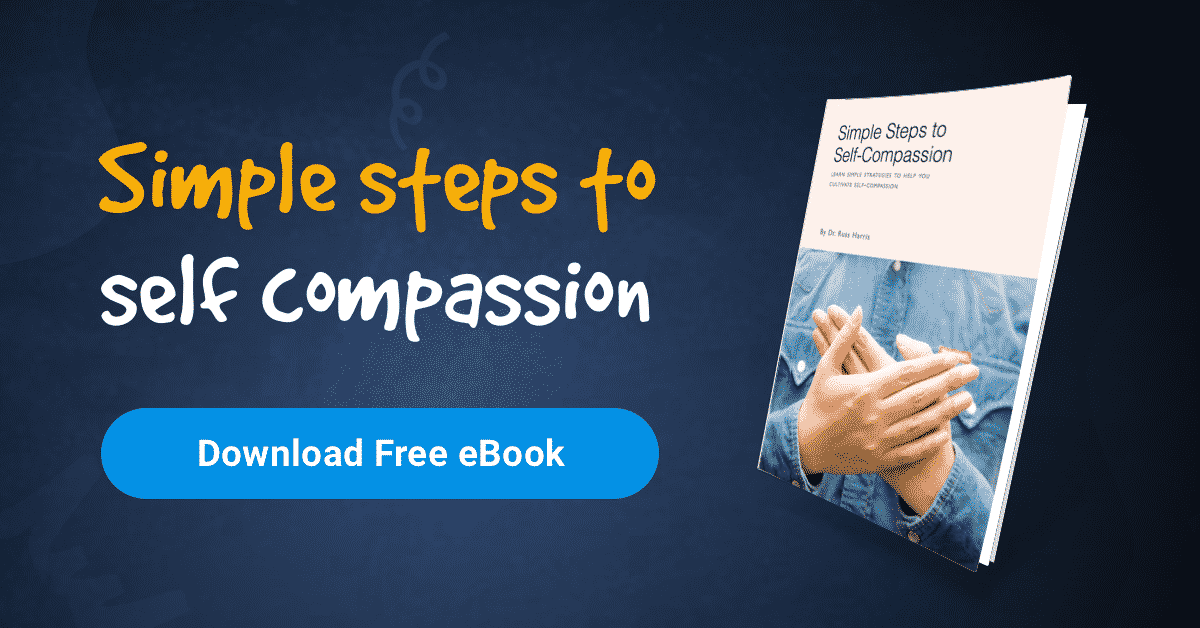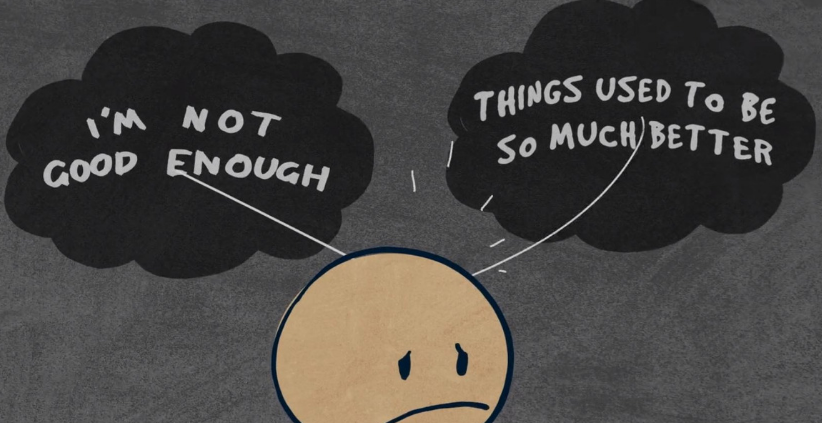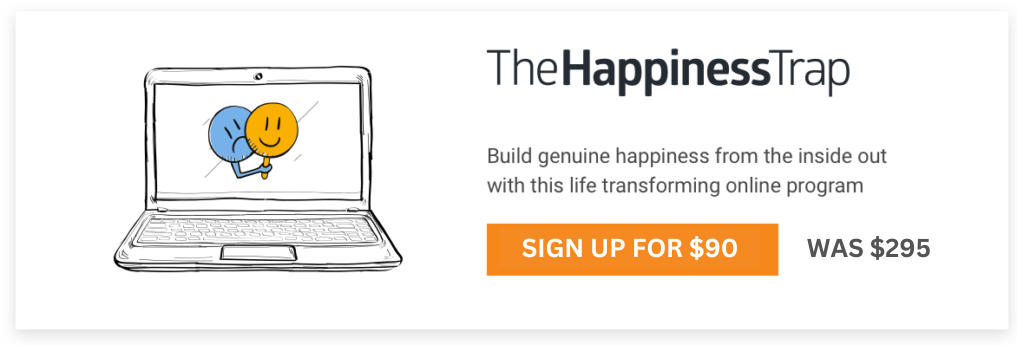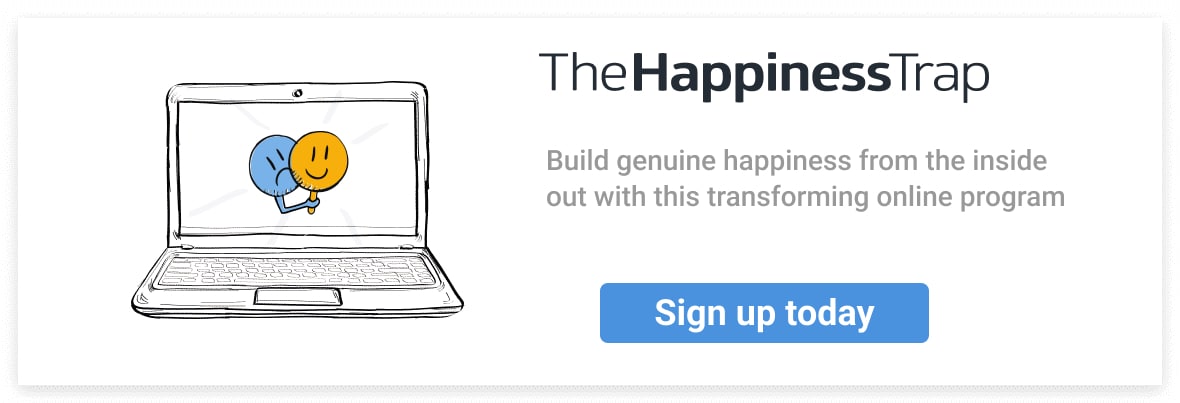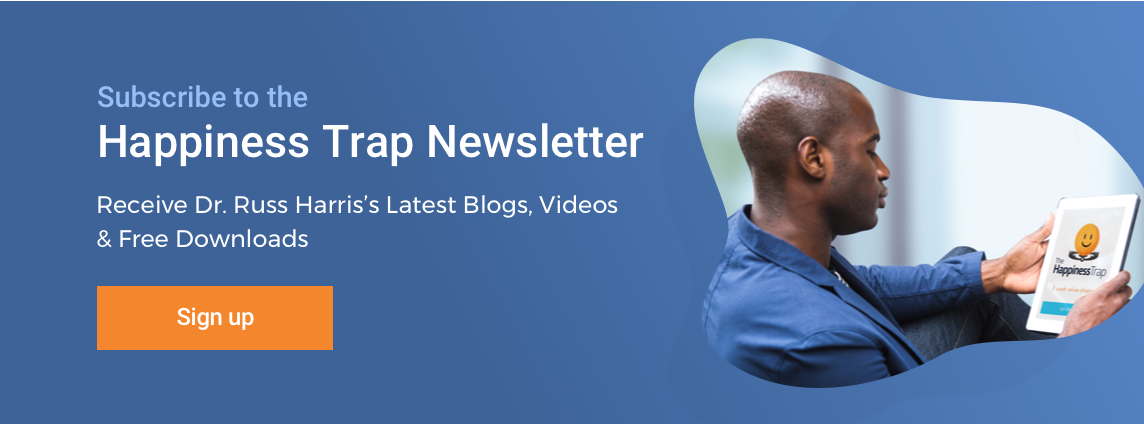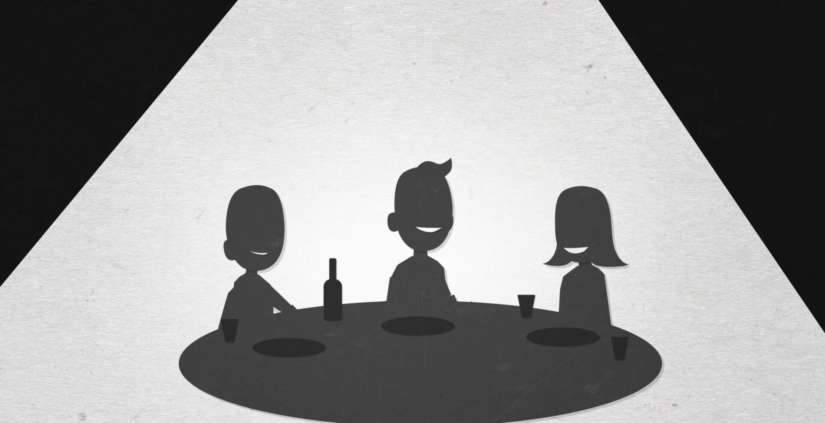

We can think of mindfulness as a psychological toolkit for enhancing your health, wellbeing and life.
- Focus, and refocus, your attention on the task or activity you are doing, and engage in it fully (focusing & engaging skills);
- Detach or unhook from difficult or unhelpful thoughts (unhooking or defusion skills);
- Savour, appreciate and enhance the satisfaction of enjoyable and pleasurable experiences (savouring skills).
Extract from the Happiness Trap, by Dr. Russ Harris
The human mind has given us an enormous advantage as a species. It enables us to make plans, invent things, coordinate actions, analyse problems, share knowledge, learn from our experiences and imagine new futures.
The clothes on your body, the shoes on your feet, the watch on your wrist, the chair beneath you, the roof over your head, the book in your hands — none of these things would exist but for the ingenuity of the human mind.
The mind enables us to shape the world around us and conform it to our wishes, to provide ourselves with warmth, shelter, food, water, protection, sanitation and medicine. Not surprisingly, this amazing ability to control our environment gives us high expectations of control in other arenas as well.
Now, in the material world, control strategies generally work well. If we don’t like something, we figure out how to avoid it or get rid of it, and then we do so. A wolf outside your door? Get rid of it! Throw rocks at it, or spears, or shoot it. Snow, rain or hail?
Well you can’t get rid of those things, but you can avoid them by hiding in a cave, or building a shelter. Dry, arid ground? You can get rid of it by irrigation and fertilisation, or you can avoid it by moving to a better location.
But what about our internal world? I’m talking here about thoughts, memories, emotions, urges, mental images and physical sensations. Can we simply avoid or get rid of the ones we don’t like?
In the outer world, we can do so fairly easily, so shouldn’t it be the same with our inner world? Here’s a little experiment. As you keep reading this paragraph, try not to think about ice cream. Don’t think about the colour or the texture or the taste of it. Don’t think about how it tastes on a hot summer’s day.
Don’t think about how good it feels as it melts inside your mouth. Don’t think about how you have to keep licking around the edges to stop it from dripping on your fingers.
How’d you do?
Exactly! You couldn’t stop thinking about ice cream. Here’s another little experiment. Recall something that happened in the past week. Any memory will do, whether it’s a conversation you had, a movie you watched or a meal you ate. Got one? Good.
Now try to get rid of it. Totally obliterate it from your memory so it can never come back to you, ever again. How did you go? If you think you succeeded, just check again and see if you can still remember it.
Now, tune in to your mouth. Notice how your tongue feels. Run it over your teeth, your gums, your cheeks and the roof of your mouth. Now try to get rid of those sensations. Try to turn your mouth totally numb, as if you just had a shot of novocaine from the dentist. Were you able to forget the sensations?
Now consider this hypothetical scenario for a moment. Suppose someone put a loaded gun to your head and told you that you must not feel afraid; that if you should feel even the slightest trace of anxiety, they will shoot you.
Could you stop yourself feeling anxious in this situation, even though your life depended on it?
(Sure you could try to act calm, but could you truly feel it?)
Okay, one last experiment. Stare at the star below then see if you can stop yourself from thinking for 60 seconds.

That’s all you have to do. For 60 seconds, prevent any thoughts whatsoever from coming into your mind — especially any thoughts about the star!
Hopefully by now you’re getting the point that thoughts, feelings, physical sensations and memories are just not that easy to control. It’s not that you have no control over these things; it’s just that you have much less control than you thought.
Let’s face it, if these things were that easy to control, wouldn’t we all just live in perpetual bliss? Of course, there are a few self-help gurus who claim to live in such a state all the time. Such people often get really rich, their books sell by the million and they attract huge followings of people desperate for ‘the answer’.
My guess is that many readers of this book will have already gone down that path and been sadly disappointed.
A lot of us get stuck because we focus on things that are outside of our control. The more we do this, the more disempowered we are, and the more frustrated or disappointed or angry or anxious we feel.
In contrast, the more we focus on what’s in our control, the more empowered we are; we can actually do something useful.
So here are some ideas to help you get clearer about what definitely is not in our control, and what isn’t, in our control, and what potentially is:
Outside My Control
- Vast majority of my emotions & feelings
- Vast majority of my thoughts
- Vast majority of my sensations
- My memories
- Whether or not I achieve my goals
- How good I feel when doing what I do
- What other people say and do
- How others perceive my motivations
- How others judge or perceive me
- What happens in the future
- What happened in the past
- Inevitable painful losses in life
- Whether or not life gives me what I want
- The inevitability of ageing, illness and injury
Within My Control (Potentially)
- How I respond to my emotions & feelings
- How I respond to my thoughts
- How I respond to my sensations
- How I respond to my memories
- How much action I take towards my goals
- How much I focus on & engage in what I do
- What I say and do to influence other people
- How much I use my values for motivation
- Whether or not I act like the sort of person I want to be
- What I say and do to influence the future
- How I respond to thoughts about the past
- Being self-compassionate when losses occur
- The values I live by, whether or not life gives me what I want
- How I take care of and look after myself
Note the very important word “potentially.”
If we’re on auto-pilot, being jerked around by our thoughts and feelings, we’re not likely to be able to exert control in these areas.
But if we are mindful – that is self-aware, present, engaged in what we are doing, able to let our thoughts and feelings flow through us without getting hooked by them – then we can exert control in these areas.
Of course, this isn’t an exhaustive list; I’m sure you can think of other things to add on both sides. However, it’s a good start. So if you want to empower yourself, then get mindful and focus on the stuff within your control.
Good luck!
D) Routines
If you get up every morning at the same time to meditate or exercise or do yoga, over time that regular routine will become habitual.
In other words, you won’t have to think so hard about doing it; it will start to come naturally; it will require less ‘willpower’; it will become a part of your regular routine. So experiment: see if you can find some way to build a regular routine or ritual around your new behavior.
So it starts to become part of your way of life. For example, if you drive home from work, then every night, just before you get out of your car, you might do two minutes of mindful breathing, and reflect on what values you want to live by when you walk through the front door into your home.
E) Relationships
It’s easier to study if you have a ‘study-buddy’; easier to exercise if you have an ‘exercise-buddy’. In AA programs, they team you up with a sponsor who is there to help you stay sober when the going gets tough.
So can you find a kind, caring, encouraging person who can help support you with your new behavior? Maybe you can check in with this person on a regular basis, and tell them how well you are doing, as mentioned in Rewards.
Or maybe you can email your support person the Records you’ve been keeping. Or maybe you can use the other person as a Reminder; ask them to remind you to do the new behavior, if and when that would be useful. For example, you might say to your partner, ‘When you see me worrying, can you please remind me to do some mindful breathing?’
F) Reflecting
Regularly take time to reflect on how you are behaving, and what effect it is having on your life. You can do this via writing it down – Records – or in discussion with another person – Relationships.
Or you can do this as a mental exercise throughout the day, or just before you go to bed, or just as you’re waking up in the morning. You simply take a few moments to reflect on questions such as:
- “How am I going?”
- “What am I doing that’s working?”
- “What am I doing that’s not working?”
- “What can I do more of, or less of, or differently?”
Make sure you also reflect on the times that you STOP doing the new behaviour, and fall back into the old one. Notice what triggers those relapses and setbacks, and notice what it costs you – i.e. how do you suffer? – when that happens.
This doesn’t mean beat yourself up! This means non-judgmentally reflect on the genuine costs to your health and wellbeing of falling back into old habits – and use your awareness of the suffering this causes you to help motivate yourself to get back on track.
G) Restructuring
We can often restructure our environment to make our new behaviour easier, and therefore more likely to sustain.
For example, if the new behavior is ‘healthy eating’ we can restructure the kitchen to make that easier: get rid of or hide away the junk food, and stock the fridge and pantry with the healthy stuff.
If we want to go to the gym in the morning, we could pack up our sports-gear in our gym-bag, and place it by the side of the bed or somewhere else obvious and convenient, so it’s all ready to go as soon as we get up.
(And of course, when we see our gym kit lying there, it acts as a Reminder.)
So there you have it.
‘The seven Rs’: Reminders, Records, Rewards, Routines, Relationships, Reflection, and Restructuring.
Now be creative; mix and match these methods to your heart’s content, to create your own set of tools for lasting change.
Good luck with it!
It’s a lot easier to start some new type of life-enhancing behaviour than it is to keep it going. How can we sustain new patterns of behaviour, until we’ve done them for so long they become habitual?
And for those of us who are therapists, coaches, or other types of health professional: how can we help our clients to keep up new behaviour between sessions?
Well, there are hundreds, if not thousands of tools out there to help us with this challenge, but we can pretty much bundle them all into what I like to call ‘The Seven Rs’: Reminders, Records, Rewards, Routines, Relationships, Reflecting, and Restructuring. Let’s take a look at each.
A) Reminders
We can create all sorts of simple tools to help remind us of the new behavior we wish to persist with. For example, we might create a pop-up or a screen saver on our computer or mobile phone with an important word or phrase or symbol that reminds us to act mindfully or to utilize a particular value.
We might use the old favourite of writing a message on a card and sticking it on the fridge or propping it against the bathroom mirror or taping it to the car dashboard.
Or we might write something in a diary or calendar or in the ‘notes’ app of a smartphone. We might write just one word, like ‘Breathe’ or ‘Pause’ or ‘Patience’, or we might use an acronym like ‘A.C.T.’ or ‘S.T.O.P.’, or a phrase like ‘Letting go’ or ‘Caring and compassionate‘.
Alternatively we might put a brightly-coloured sticker on the strap of our wristwatch or the back of our smartphone or the keyboard of our computer, so that every time we use these devices, the sticker reminds us to do the new behaviour.
B) Records
We can keep a record of our behavior throughout the day, noting down when and where we do the new behavior, and what the benefits are; and also when and where we do the old behavior, and what the costs are. Any diary or notebook – on paper, or on a computer screen – can serve this purpose.
C) Rewards
When we do some form of new behavior that involves mindfully acting on our values, hopefully that will be rewarding in its own right. However, we can help to reinforce the new behavior with additional rewards.
One form of reward is kind, encouraging self-talk, e.g. saying to yourself: ‘Well done. You did it!’ Another form of reward is sharing your success and progress with a loved one who you know will respond positively.
On the other hand, you might prefer more material rewards. For example, if you sustain this new behavior for a whole week, you buy or do something that you really like, e.g. get a massage or buy a CD.
We all have times when we don’t feel so good. And in those moments, many of us ask ourselves the perfectly reasonable question “Why do I feel like this?”
Now there’s a bright side to this question … and there’s also a dark side.
The Bright Side
The bright side of this question is that it can help to alert us to issues we need to deal with.
For example, suppose the answer is we’ve been fighting with our partner, eating too much junk, drinking too much, not getting enough sleep, working too hard, not exercising enough, smoking, taking drugs, partying too hard, worrying about our kids, coping with an illness, struggling financially, racing to meet a deadline, facing the death of a loved one.
If so, then recognising those issues as the trigger for our painful emotions is a useful first step. And the second step is then: take action! Do something practical, useful and helpful to effectively deal with or adapt better to the situation.
Now usually, such issues are obvious – and you can identify them easily and instantly when you ask yourself the above question. But suppose you find that there is no obvious answer for why you are feeling down or anxious or sad or grumpy; what happens if you keep on asking yourself the question?
Well, that’s where things go awry. If you keep asking yourself “Why do I feel this way?” when there’s no immediate obvious answer, it usually just hooks you into …
The Dark Side
The dark side of this question is what psychologists call “rumination”. We get lost in our thoughts, analysing all the possible reasons for “why I feel like this”.
Usually, we then start running through all the unpleasant things that have happened to us, all the things that are wrong with our life, all the things that aren’t good enough in ourselves or others or the world around us, wondering if any of them might be the cause.
Naturally this pulls us more and more into discontentment, dissatisfaction, as we run through everything that’s lacking in our life. (Hardly surprising that this pattern of thinking plays a big role in depression.)
So when you catch yourself caught up in this type of thinking, it’s a good idea to unhook from it:
- Notice the thinking process and silently name it: “Aha! Here’s my mind trying to figure it out again” or “Aha! There’s the ‘why do I feel like this?’ story” or “Here’s rumination” or simply “Analysing”.
- Use your mindfulness skills to unhook from theses thoughts and get fully present
- Start doing some meaningful, life-enhancing activity, and give it your full attention
- Engage in what you’re doing
- In this manner, repeatedly unhook yourself from the “Why do I feel this way?” story – over and over and over again; and repeatedly refocus on the activity you are doing.
But What Do I Do About The Feeling?
- Use your mindfulness skills to practice acceptance of the feeling, and be self-compassionate.
- Take action: do whatever you can to improve the situation or solve the problem that’s triggering it.
- And if there’s no effective action you can take, stick with A). But stop trying to analyse the feeling, and instead put your attention and energy into doing something meaningful.
Remember feelings change like the weather; and sooner or later this feeling, no matter how unpleasant, will pass.
The Happiness Trap Online Program
The Happiness Trap Online Program is based on an empirically-supported model known as Acceptance and Commitment Therapy (ACT).
Over a 35 year period, evidence has mounted for ACT’s effectiveness in treating conditions including anxiety, chronic pain, depression, stress, smoking, weight loss and performance enhancement.
The Happiness Trap program teaches highly-effective strategies and interventions based on the ACT model, which can help you stop struggling with difficult thoughts and feelings and build genuine and lasting happiness.
We say ‘happy holidays’, but the truth is, for many of us the festive season is a less-than-perfect mixture of both delight and dread. I, for one, have had plenty of holiday misery over the years – from difficult divorces (first my parents, then later my own!) to deaths of loved ones to family feuds, and so on.
Let’s face it: when the holidays happen, there are many potential sources of stress and suffering. For some people it’s a time of great loneliness; for a whole host of reasons you may feel cut off, disconnected, or isolated from others.
For other people, it’s a time of grief – especially if a loved one is very sick or dying, or if it’s the first Christmas since they died. And for almost all of us there are the perennial stresses of buying gifts (what to get, how much to spend, will they like it or not?), challenging social events (difficult relatives, family arguments, drunken revellers), competing family demands (with whose family members, on which days, do you celebrate what?) or just grappling with the logistics of hosting a feast.
For most of us, there’s a pretty big gap between the ‘festive season’ that’s promoted in popular culture – happy, harmonious friends and families, enjoying a blissful gathering – and the one that we get to experience in real life. And this in itself easily leads to frustration and disappointment, on top of all those other forms of stress.
So, what can we do to make the most of the holiday season while handling the stress that inevitably goes with it? Well, to quote the author H.L. Mencken,
‘For every complex situation, there is an answer that is simple, clear and wrong’. Wise words, huh? So, I’m not going to even attempt a simple answer. There just isn’t one.
Instead, what I’m going to suggest is a simple practice; something that can help you cope when the going gets tough. What I have in mind is the practice of ‘compassion’ – which basically means, to acknowledge suffering and respond with kindness.
Throughout the holiday season, when life is hard, acknowledge it. Pause for a moment, and truly acknowledge your difficulties and disappointments, and all the unpleasant feelings that go with them. Acknowledge, openly and honestly that it’s painful.
And then respond to your pain with genuine warmth and kindness; treat yourself like you would treat someone you love, if they were in a similar situation. (For more on how to do this, read my previous blog, The No BS Guide To Self-Compassion
Of course, practicing self-compassion won’t magically make your holidays into ‘happy, happy, happy’! But it will help you to cope with the challenges better.
And at the same time, look for opportunities to be compassionate to others. After all, they too are likely to be struggling.
And if you can reach out to your loved ones during those difficult times, and be there for them in a kind and supportive way, one of the greatest gifts you can ever give. As the ancient philosopher Philo put it: ‘Be kind, for everyone you meet is fighting a hard battle.’
We often find ourselves in situations that we don’t want to be in or having to do things we don’t particularly like.
But what happens if we take the time to get in touch with our values; to clarify what sort of person we want to be and how we want to treat ourselves and others?
Once we know our values, we can ‘sprinkle’ them into our actions; use them to ‘flavour’ whatever we are saying and doing. And almost always when we do this, whatever we’re doing then becomes far more rewarding.
For example, consider the case of Rob, a 22-year-old university student.
While Rob was studying a five-year architecture course, he was working part-time as a waiter to help pay his way. He told me that he hated his job, but he needed the money to pay for his food and board.
He knew it was only temporary and that in one more year he’d be working as an architect, but that didn’t stop him from dreading every shift.
It wasn’t that he worked in a horrible place or had some terrible boss; he just didn’t like the work. The only other part-time work he could get was cleaning, stocking shelves, serving hamburgers or bartending, and these were, in his opinion, even worse.
I questioned him about his values and how he could use them to transform his relationship with his job.
He identified values such as mindfulness, caring, curiosity, openness warmth and humour. I then asked him what might happen if he engaged mindfully with the customers?
What difference might it make if he were to be fully present? To pay attention with openness and curiosity to the clothes they wore, the style of their hair, and the tone and rhythm of their voices? To notice the way that they ate and drank and spoke?
To notice their facial expressions and physical gestures? And what might happen if he was more caring about the customers: if he cared about their experience in the restaurant and the quality of his service?
Inspired by this way of thinking, Rob had an idea. He would become a ‘Zen master of pizza delivery’. He would connect mindfully with his body to ensure he had the best possible posture and carry that pizza as if it were a priceless work of art.
He would be more caring about how he lowered that pizza to the table; he’d lay it down as if placing it in front of a king. All the while, he would contribute warmth and good grace and he’d also share his excellent sense of humour.
And the result? Well, his work didn’t magically turn into some ‘dream job’, but it did become much more fulfilling.
He wasn’t ‘just waiting pizzas’ anymore; now he was contributing to people’s lives, challenging his body, engaging in the world, developing his mindfulness skills and having moments of fun along the way.
He was staggered by the difference it made. The dread disappeared and so did the boredom. There was still a huge difference between the job he ideally wanted and the one he had, but he had discovered the fulfilment of living by his values.

